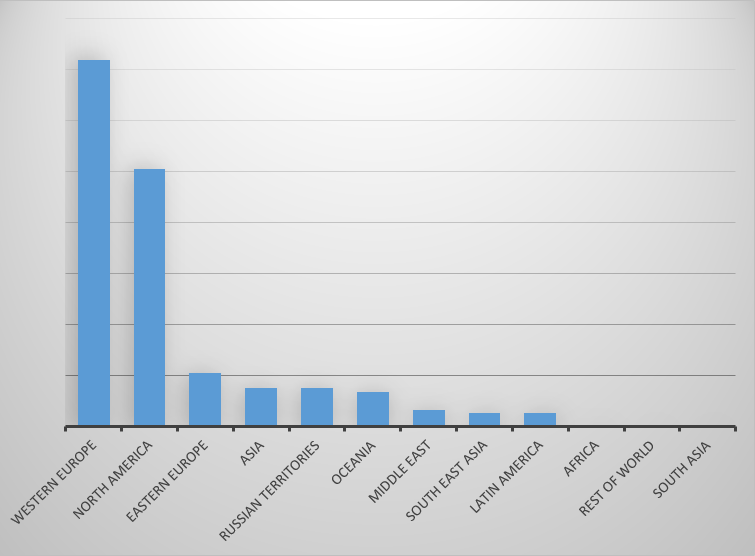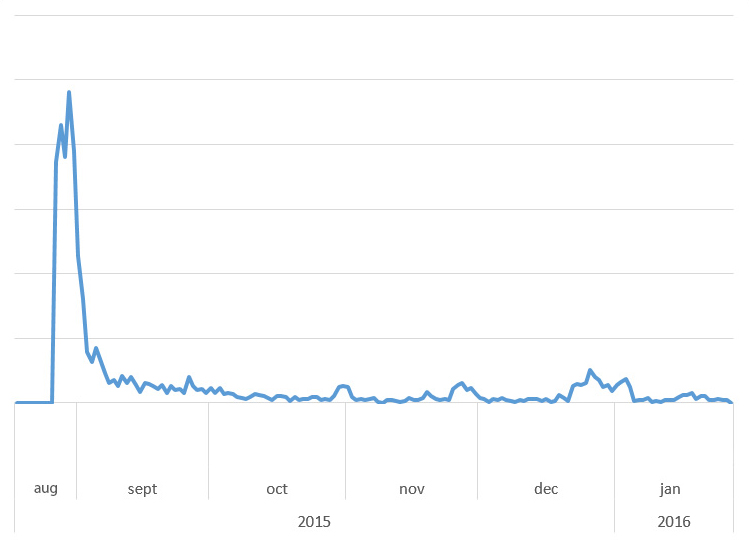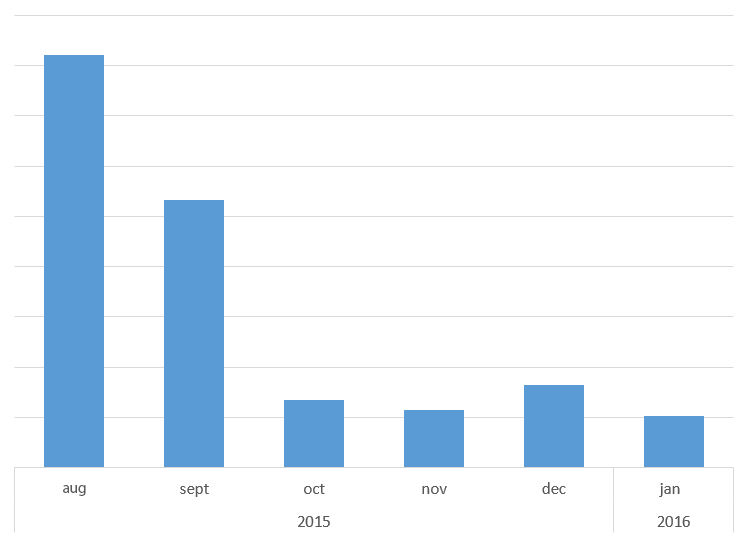Trending
Opinion: How will Project 2025 impact game developers?
The Heritage Foundation's manifesto for the possible next administration could do great harm to many, including large portions of the game development community.

Featured Blog | This community-written post highlights the best of what the game industry has to offer. Read more like it on the Game Developer Blogs or learn how to Submit Your Own Blog Post
The Numbers of the Beast. 5 months after releasing our indie game on PC, a whole lot of data on how much did it cost, how we fund it, how did it sold and some datas about the players. Real fun!

This is the second part of a series of post mortems about Dead In Bermuda, a survival management indie game released on PC in August 2015, made by CCCP and published by Plug In Digital Label.
This one is more focused on numbers. You can check the first part here.
Hey! Some numbers, yay!
A few words before going into the depths of the indie game business, sadly there are some data that I couldn’t share because of stores’ Terms & Conditions and contracts’ Non-Disclosure Agreements. I shared all that I could, but sorry if it gets a bit vague sometimes.
(All the numbers will be in € to have some consistency between them all, don’t forget to convert to USD if you’re not from Europe!)
To the release date, the game exactly cost us 113 826€ to make in terms of production costs (= development of the game).
After release, we worked a bit on patches and fixes, to an extra 12 109€ cost.
So we can say that the actual total development cost is 125 935€.
The team was comprised of 3 persons: a game designer, a coder and an artist.
The costs between these 3 were divided like that:
Game Design | 114 days |
|---|---|
Code | 211 days |
Arts | 134 days |
It took approx. 12 months to complete, considering that sometimes we worked on other projects while waiting for things to happen, like funding confirmations, big decisions, holidays, etc…
To this budget, we can add a few external costs:
Sound & music
Trailer
Localization
Playtest
I won’t go into the exact amount for each of these, to keep business secrecy, but I can say that in total it didn’t exceed 10 000€ for us.
To that you can add the marketing costs too, but since we have a publisher it’s him who handles all these costs, and I can’t tell you how much it represents. But you have to know that it’s not 0€: going to exhibitions, contacting press, making all the relations with the different stores, etc… It costs money! That’s why you either need a publisher or you must handle these costs yourself, so in the end it always costs you something, and something big.
Note: there are also costs associated with office rental, software licenses, hardware, etc… But all these costs are calculated and divided amongst every employee within the company and then added to the base cost of a person in the team, so we didn’t forget them.

Okay, so now that you know how much it cost us, how can you have the money to make this happen?
Because yes, I know it’s kind of rare in these kind of indie post mortems, but we are an actual company, so we pay monthly wages to our developers so we must find a way to get this money BEFORE starting making our game… We are not students, we are not freelances, we can’t say “it took us 12 months to make the game but we don’t pay ourselves so in fact it cost us 0€ to make”… That’s not true, when you work on something during an amount of time it represents actual money, even if you live at your parents and they feed you (consider the money you would have gained if you made a paid work during this whole time, that’s it, that’s the cost of your time!)
SO, back on track, when you start a project, you try to figure out how much it will cost and find a way to get this money. We figured the game would cost 130 000€ to make, so in the end we were very close to what we planned. And that’s how it should be…
So we funded these 130 000€ with 3 means:
We won a regional contest. That’s not free money, you must give royalties back to the fund, but it enables you to actually start something.
Because this fund cannot fund more than 50% of the development costs, we funded quite a lot ourselves too. That is to say, with money we earned as a company with other projects, and we invested this money into the game.
And we needed a bit more to complete the budget. These were provided by our publisher, Plug In Digital. It’s not “free” either, like all publishers they give you money to develop your game but take all the royalties (= the money you get by selling your game) until they recoup the money they put into the development, and then they take their share of the royalties.

A small point about the revenue sharing model in the game business, it’s well known but maybe someone on Earth doesn’t know how it works: on the base selling price of your game, that’s how the money is distributed:
First, the store (who actually get the money from the buyer/player) takes his share (often, it’s around 30%) and gives the rest to your publisher (minus taxes)
The publisher takes 100% of this until he recouped his investment, and then he takes a share (it can be anything as low as 10% to 90%... depending on many factors)
The rest is for the developer, us.
And in our case, our regional funder takes a share on this rest, because they helped us fund the development. (I can’t divulge the amount)
So on the big total amount of money a game makes, the developer doesn’t get the whole pie… And sometimes, doesn’t get any slices at all.
But that’s not our case! :) I can say that on a 14.99€ base price, in the end we get between 3 to 4€, minus taxes. That’s not bad! You could get the same amount of revenue sharing with a 60€ game… So we consider ourselves lucky.
We launched the game on Steam and other PC platforms on the 27th of August 2015, so we have now 5 full months of data.
We sold nearly 10 000 units of the game on all PC and MAC stores.
It represents a gross sale amount of about 100 000€.
From that you subtract taxes, stores, publisher and our regional funder’s royalties. I can’t tell you exactly how much we really gained, but it’s less than 50% of the gross sale amount.
If we add the money from the regional fund + the publisher’s advance + royalties on sales, we reached 71% of the total cost of the project. That’s not ideal, but that’s not bad either. With the sales we are making right now, which are low but steady, we should recoup within 12 months after its launch.
So here are a few data we collected from the different PC stores. I erased the values, but with that you can get an overall look at the sales data.

Gross units sold by region. The game was launched in EN and FR languages, and translated to ES+DE+RU about one month or two after launch.

The top 10 selling countries. Poland seems to be a good market that shouldn’t be forgotten. Russia numbers suffers from pirated copies I guess. Despite being translated to Spanish, the game didn’t do very well in Spain it seems.

Gross units sold over time. Launch is clearly a wonderful time, that doesn’t last very long… The spikes are special offers periods on the stores.

Gross units sold by month. After the first month, you quickly reach your lowest sale point. The good news is that there seems to be a minimal amount of sales you’ll do in a month, very low but very steady. With the big sales period of the end of the year, we doubled the revenues on the month, so it helps a lot.
Since we were very close to the launch of the game, we only did special offers at -30% sale price for now, but larger discounts will surely mean more revenues (it seems absurd at first, but it’s true).
We got a real surge of piracy when a hacked Chinese version of the game popped up in torrent websites.
With the numbers we have, I can say that at least 75% of the players of the game play with a pirated version. That represents 450 000€ in gross sales, more or less.
We could say it’s a big money loss, and that if these players paid for the game we would have managed to recoup our costs and have some good money to invest into a sequel.
We could argue that the majority of these people wouldn’t have paid for the game in any case, so I tend to be relaxed about it. Oddly enough, you can also see a little spike in sales when the pirated versions came out, maybe it raises a bit the game’s awareness, and a small % of pirates tend to actually buy the game after trying it (it would need to be measured).
It may seem old school, but we have a free demo for our game… Crazy. I didn’t thought it would do much at first, but it clearly was a very good idea.
You can play the game for the first 5 ingame days (approx. 1h30), without any limitation, and you can keep your save if you buy the game, so I think the deal is rather interesting.
And the good number is that we have 20% of demo players that bought the game afterwards… Wow! Really good conversion rate! I think the demo was long enough to engage players into the story and gameplay loop, and it finishes right at the perfect time: you’re starting to grasp the gameplay, it’s getting challenging and you’re starting to see mysterious story elements while exploring the jungle.
Forums
50% of the people who bought the game came to the forums at least once. That’s cool! We like talking with players on the forums, it’s really rewarding to see that players liked what you did, are wondering how things works, etc… It gives energy. Even the ones who didn’t like the game, you are boosted to understand why they didn’t and what you can do better next time!
Data in a solo, premium game doesn’t have as much meaning as in a free-to-play app, but it’s always good to have some feedback to have real proof of where your game is failing. We don’t have much data, but here are some that can be interesting:
Players play on average 2 hours per session to our game.
Players play on average 1.2 sessions per day.
30% Day 1 retention.
Players tend to finish the game in 15-20 hours.
In our game, the questline is divided in 8 big steps (don’t want to spoil here, so I’ll keep it vague).
100% of players reached the first step (less than 1 hour of gameplay, on average)
75% reached the second step (2 hours or so?)
36% reached the third step (that’s the point where the game gets really tough and it can be very long to reach this step if you’re struggling. So the numbers make sense)
14% reached the end of the game: so we can say, if you passed the third step, you’re on the right track to finish the game, there are no more big difficulty spikes after that.
What can we get out of these numbers?
I think that if we make a sequel, I’ll try to avoid having a so big difficulty spike towards the first half of the game, but instead having more small difficulty spikes all along the game length, to keep people engaged into the game and challenged until the end of the story.
I liked the look of the difficulty curve I got in the first game, because it made sense that you have many resources at beginning but when they ran out you’re left alone and it gets really hard if you didn’t prepare well, and then when you have your camp and your resources supplies set up, it’s easier for you.
It’s rather “realistic” but in the end it’s a big potential source of complain from players: some will drop the game after failing the first big difficulty spike, and find the game too hard, and some will like this challenge but will be disappointed that it gets easier as time goes by, so yeah it’s no big surprise but you need to get away from realism when you design a game, because real life doesn’t necessarily have a fun difficulty curve :)
Read more about:
Featured BlogsYou May Also Like